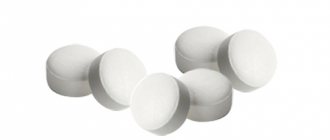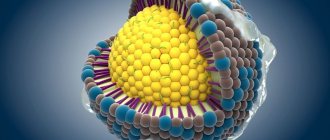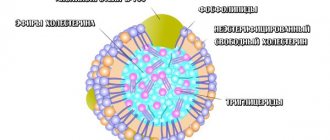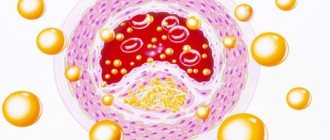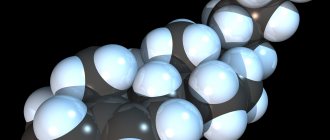Lipoproteins are a complex indicator that consists of lipids and proteins that interact during metabolic metabolism.
One of the main properties of lipoproteins is the movement of triglycerides and cholesterol throughout the body during blood circulation.
The risk of atherosclerosis progression can be accurately determined using the atherogenicity coefficient, which determines the ratio between good and bad cholesterol.
Classification
In medicine, there is a certain division between lipids, which divides them into main fractions.
Their full classification is given in the table below.
| Name | Description |
| Low-density lipoproteins (LDL) | The main task of this fraction is to move lipids, vitamin E and other liver compounds through the blood vessels. LDL contains the largest amount of cholesterol, which gives it a high rate of atherogenicity. |
| An increased concentration of this fraction indicates the risk of developing cardiac ischemia. The increase in this indicator is provoked by the following factors: | |
| · Sedentary lifestyle; | |
| · Diet with a lot of calories; | |
| · Violation of hormone production; | |
| · Liver pathologies; | |
| · Hereditary predisposition; | |
| · Influence of alcohol or cigarettes. | |
| Very low density lipoproteins (VLDL) | This fraction is characterized by sizes smaller than XM, but they are very similar in structure. The main difference between VLDL and CM is that they contain a higher concentration of cholesterol, phospholipids and proteins, while triglycerides (TG) are contained in a smaller proportion. |
| LDLNP is synthesized in the liver cavity, from where TG and other lipoproteins begin to be transported throughout the body. It is important to realize that an increase in the level of VLDL in the blood, through food entering the body, increases the risk of developing atherogenic diseases. Also, the concentration of VLDL may increase due to a hereditary disorder or a violation of the production of renal hormones. | |
| Intermediate density lipoproteins (IDL) | This fraction appears after VLDL is exposed to LDL and lipoprotein lipase. If you conduct a blood test on an empty stomach, then no STDs should be detected in the blood. An increase in this indicator in the blood occurs due to a hereditary predisposition or excessive consumption of vegetable fats. |
| High density lipoproteins (HDL) | This fraction is characterized by the lowest concentration of cholesterol, and half of HDL is protein. The main class of lipoproteins has the smallest complex sizes. |
| HDL synthesis occurs in the liver. Their main function is the movement of lipids from tissues to the liver, as well as the disposal of excess cholesterol from the body. In fact, this is the only way to naturally remove cholesterol from the body. | |
| It is important to control this indicator for the normal functioning of the cardiovascular system. | |
| Chylomicrons (CM) | The largest complexes among lipoproteins, which are rich in triglyceride concentration. ChMs are responsible for transporting cholesterol and fatty acids from food products throughout the body, from the intestines to the tissues, and from there to the liver cavity. |
| In a healthy state, chylomicrons form after food consumption, completely disappearing after 12 hours. That is why, when donating blood for laboratory tests on an empty stomach, they almost do not appear in the test results. |
"Good" and "bad" lipoproteins
Types of drugs
Today in medicine there are four types of lipoprotein, each of which is determined by the indicators of a biochemical blood test. Let's consider each of them separately.
Chylomicrons
This indicator is not recorded in a healthy state of the body and is noted only in cases of lipid metabolism disorders. The synthesis of these lipids occurs in the small intestine, where they are produced by the mucous membrane, or rather its epithelial cells.
They are responsible for transporting exogenous fat from the small intestine to tissues and the liver.
The predominant part of transported fats are triglycerides, the rest are cholesterol and phospholipids.
Under the influence of enzymes in the liver, triglycerides are broken down and fatty acids are formed, one part of which is combined with albumin, and the other moves to adipose and muscle tissue.
Chylomicrons
HDL
Transporting cholesterol from tissues to the liver is the main task of high-density lipoproteins. Their components are phospholipids, which help maintain cholesterol concentrations within normal limits and prevent it from leaving the blood.
HDL synthesis occurs in the liver cavity and their main task is to transport cholesterol from tissues to the liver cavity for disposal.
This type of cholesterol is also called “good”, since it is not capable of accumulating and increasing cholesterol levels above normal.
An increase in the indicators of this type of lipoprotein is recorded with excessive excess weight, death of liver tissue and a liver condition in which more than 5% of the liver mass is fat, mainly triglycerides.
The HDL complex also increases during alcohol intoxication.
Its indicators are reduced, mainly in cases of atherosclerotic (cholesterol) deposits on the walls of blood vessels, as well as in rare hereditary diseases when a decreased state of “good” cholesterol appears.
LDL
This type of lipoprotein is also called “bad” cholesterol. Low-density lipoproteins transport endogenous cholesterol, triglycerides and phospholipids from the liver directly to tissues.
This type of lipoprotein contains up to forty-five percent cholesterol and is responsible for its transport properties. Low cholesterol density is formed in the blood when lipoprotein lipase acts on VLDL.
This indicator is the most significant for diagnosing cholesterol problems. When total cholesterol levels are normal, and this indicator is elevated, this indicates a disturbance in fat metabolism and the risk of progression of the deposition of atherosclerotic plaques on the walls of blood vessels.
It is these lipids that can be deposited on the walls of blood vessels, provoking the development of atherosclerosis.
LDL levels are elevated in women and men, caused by a pathological increase in lipids in the blood, low production of thyroid hormones, as well as nephrotic syndrome, which is characterized by edema, a small amount of proteins and a high concentration of lipids in the blood.
The decline of low-density lipoproteins occurs during inflammatory processes of the pancreas, during pregnancy, in pathological conditions of the kidneys and/or liver, as well as in acute forms of infectious lesions of the human body.
Lipoproteins
VLDL
This type of lipoprotein is synthesized by liver tissues. The main task of these lipids is to move endogenous lipids, which are produced in the liver from carbohydrates, throughout the body to the tissues of the body.
They are the largest lipoproteins, second in size only to chylomicrons. The main part of them is triglycerides and most of cholesterol. If the blood composition contains a large amount of VLDL, then the blood becomes more milky and cloudy.
This type of lipid is also “bad” from which cholesterol deposits are formed on the inner walls of blood vessels, narrowing the lumen of the vessel and disrupting blood flow, which leads to the development of serious pathological conditions and even death.
Atherogenic, with the highest amount of cholesterol, are VLDL and LDL.
They are able to penetrate the vessel wall and form accumulations. If the metabolic rate is disrupted, then the level of LDL and total cholesterol increases significantly, which is recorded in a blood test.
The remaining varieties of lipoprotein classes transport cholesterol, which plays a very important role in the functioning of the body, into cells. It is responsible for the functions of forming sex hormones, synthesizing vitamin D (extremely important for the normal absorption of calcium), as well as in the process of formation of bile.
There are two types of cholesterol, the ratio of which is important 50 to 50:
- Endogenous cholesterol is produced by the human body. Synthesized in liver tissue, adrenal cells, and intestinal walls,
- Exogenous cholesterol - this type of cholesterol enters the human body through the consumption of food.
Cholesterol and LP, role in the body and norms
Atherogenic and antiatherogenic lipoproteins
Atherogenesis depends in part on the size of the lipid complex.
The compounds themselves can play different roles in it, depending on which they are divided into groups:
- Having an atherogenic effect - these are LDL, VLDL and LDLP;
- Having anti-atherogenic properties - HDL, which cleanse the vascular walls of cholesterol accumulations.
To some extent, atherogenic and antiatherogenic factors are related to the size of the lipoproteins themselves.
High-density lipoproteins do not provoke the risk of developing atherosclerotic plaques in the heart and blood vessels. This is due to the fact that they are small enough to easily pass through the vascular walls without deforming or injuring them.
This feature allows HDL not to clog the duct of the vessel and have an antiatherogenic effect on the body.
Types of lipoproteins
LDL and CM are larger in size, which contain an increased concentration of TG, and are lipoproteins that do not have atherogenic properties.
However, medical experts have proven that increased levels in the blood can lead to the progression of pancreatitis. Low-density lipoproteins after oxidation can settle on the vascular walls.
LDL and LDLP have an atherogenic effect, which quite easily settle on the vascular walls, which leads to the accumulation of cholesterol deposits.
Most often, little attention is paid to the DILI indicator, since it is only intermediate.
An increased level of atherogenic lipoproteins indicates an increased risk of progression of coronary heart disease.
In addition, the size of LDL also affects the risk of developing cardiac ischemia. As an example, in individuals who have a high concentration of low-density lipoprotein type B, the risk of progression of coronary heart disease increases by 3 times.
Classification of lipoproteins
Lipoprotein modifications
To determine the risk of developing cardiovascular diseases, not only the lipoproteins themselves are important, but also their modified forms. Lipoproteins can be modified from normal fractions, creating pathological compounds. The main reasons for this process are: the release of free radicals by cells; increased concentration of glucose in the blood; release of lipid metabolism products into the blood.
The following are the most significant modified lipoproteins:
- Lipoprotein (a) is a special type of low-density lipoprotein that differs only in some structural features. Thus, a polypeptide protein chain is additionally attached to the lipoprotein (a) cell. This leads to the fact that lipoproteins (a) selectively begin to accumulate on the walls of blood vessels, and an inflammatory process develops in them.
- Oxidized LDL. As a result of the entry of a large number of free radicals into the blood, the lipids of the LDL membranes are oxidized and the products of lipid peroxidation are introduced into them. This process initiates the appearance of foam cells, which become the building material of atherosclerotic plaques.
- Glycated LDL. When glucose attaches to low-density lipoprotein proteins, the structure of the latter changes. They are modified and, in their new structure, are able to linger in the bloodstream, undergoing additional oxidation and depositing on the walls of blood vessels.
- Small, dense LDL. They belong to the most important group of modified atherogenic compounds. They contain a sufficient amount of cholesterol and phospholipids, while their structure is similar to arterial cells. As a result of complex biochemistry, all phospholipids and cholesterol are released from mLDL, which are subsequently deposited on the vascular endothelium.
- Modified HDL. During the synthesis of HDL in liver cells, some compounds are released with defects, the properties of which transfer the modified HDL from the category of antiatherogenic to atherogenic.
The presence of these complexes in the blood plasma leads to disruption of fat metabolism in the body, which is fraught with atherosclerotic changes in blood vessels. Modified lipoproteins can be recognized using a detailed lipid profile. Such a study must be carried out if severe disorders of lipid metabolism in the body are suspected, as well as in their hereditary forms.
What do atherogenic lipoproteins consist of?
The shape of lipids is presented in the form of a ball of protein molecules, and their main task is to move cholesterol, triglycerides and other components throughout the body. Each fraction has a different size, properties and structural components.
Lipoproteins look like spheres, in the center of which triglyceride and cholesterol compounds are located, forming a hydrophobic core.
This spherical structure is densely surrounded by phospholipids and apoproteins, which react with many receptors and help lipoproteins perform their functional duties.
In medicine, there are several types of apoproteins, which are listed in the table below.
| Species of aposquirrel | Description |
| A1 | Responsible for moving cholesterol from peripheral tissues to the liver cavity, and also helps remove excess cholesterol from the body. A1 is the main component of high-density lipoproteins. |
| IN | This type of apoprotein makes up the predominant part of chylomicrons, very low, low and intermediate density lipoproteins. It helps the mentioned transporters transfer fats to tissues. |
| WITH | It is a component of HDL. |
Low density lipoproteins
Blood lipoproteins (lipoproteins)
The main lipids found in blood plasma are cholesterol, triglycerides and phospholipids. They are vitally necessary for the body to carry out many functions, but due to their characteristics, in particular, their insoluble structure, proteins - apolipoproteins - are required for their transfer to the cells of tissues and organs. By binding to them, lipids can move freely along with the blood flow.
Thus, blood plasma lipoproteins are a complex of proteins and lipids that have a water-soluble structure, which allows them to be actively involved in metabolic processes.
All known lipoproteins contain cholesterol, triglycerides and phospholipids, but their proportions differ depending on the fraction of the lipid compound. Lipoproteins also differ in other parameters: compound size, apoprotein groups, flotation speed, complex density.
What is the atherogenic coefficient?
To determine this indicator, it is necessary to assess the state of lipid metabolism.
When conducting a laboratory study of a lipid profile, the following indicators are determined:
- Total cholesterol;
- Triglyceride;
- HDL;
- LDL;
- VLDL;
- Atherogenic coefficient (AC).
The study is carried out according to the following formula:
Then the atherogenicity coefficient itself is determined as follows:
Increased results for this indicator indicate the risk of developing diseases in the body.
A person with improved results requires drug therapy, diet, and an active lifestyle.
Biochemical blood test for lipoproteins
A biochemical blood test is prescribed to collect information about the metabolism in the body, the quality of work of internal organs and human systems, and the level of macroelements - proteins, fats, carbohydrates. Biochemical analysis is done as part of a medical examination for hidden diseases and pathologies. It allows you to identify the problem even before the first symptoms of the disease appear.
One of the parameters under consideration in a biochemical blood test is lipoproteins of various densities - components of fat metabolism.
If it is determined that the content of low-density lipoproteins in the blood is increased, this means that there is “bad” cholesterol in the body and additional examination is required to detect atherosclerosis.
Based on the indicators of lipoproteins of different densities, the value of total cholesterol in the blood is derived. To assess the condition of blood vessels, the indicators of individual low-density lipoproteins are more important than total cholesterol.
In order for the results of a biochemical blood test to be reliable, it is necessary to stop taking alcohol and strong medications 24 hours before, not to eat anything or drink sweetened drinks 12 hours before, not to smoke or drink anything other than water 6 hours before.
The results of the analysis may differ greatly from the norm in the absence of diseases of the internal organs during pregnancy, within one and a half to two months after childbirth, a recent infectious disease, severe poisoning, or acute respiratory infection. In this case, a repeat test is indicated after eliminating the interfering factors.
To obtain a more detailed result on lipoprotein levels as part of the diagnosis of cardiovascular diseases, a blood lipid profile is prescribed. It shows how much and what lipoproteins are contained in the blood, and also talks about the level of cholesterol and triglycerides.
Causes of imbalance
Deviations of lipid fractions from the norm lead to the development of atherosclerotic deposits and a number of other diseases provoked by cholesterol plaques.
The main factors influencing impaired fat metabolism are:
- Sedentary lifestyle and low physical activity;
- Constantly being in stressful situations - in such situations, the production of cortisol increases and the insulin level decreases. All lipid fractions also increase, which increases the risk of developing pathologies of the heart and blood vessels;
- A diet containing a large amount of fat;
- Alcohol and cigarettes;
- Obesity;
- Hereditary disposition;
- High blood pressure;
- Diabetes and other pathologies in which the production of hormones is disrupted;
- Liver and kidney pathologies;
- Use of certain types of medications.
LDL
What are lipoproteins?
Fat is produced by liver cells, but it needs protein to become a vehicle.
With a sufficient amount of protein in a lipoprotein molecule (over 50.0%), this molecule has a high density and serves as a building element of the cell membrane in the body.
The lipoprotein membrane contains:
- Protein molecules, cholesterol fat molecule, and phospholipid molecules;
- The lipoprotein is hydrophilic, therefore it has the properties of binding to the plasma of the blood composition.
The inner core of the lipoprotein has the following molecular composition:
- Ester of a fatty compound (cholesterol);
- Triglyceride molecules;
- Fat-containing acid;
- Vitamin A.
If lipoproteins have a stable standard concentration, then they support the synthesis of fat molecules and components of apoprotein particles (protein in high molecular weight lipoprotein).
Lipoprotein
When is it sent for analysis?
In most cases, doctors write a referral for laboratory testing of the lipid spectrum in the following situations:
- Once every 5 years with regular examination as a preventive measure;
- If elevated levels of total cholesterol are detected;
- If they have direct factors that increase the risk of developing atherosclerosis (age category over 45 years, excess weight, nicotine consumption, diabetes, low physical activity);
- With a hereditary predisposition (if relatives have recorded pathologies of the heart and blood vessels, diabetes, death of heart muscle tissue, or stroke);
- To monitor the effectiveness of the course of treatment used.
To get the most accurate lipid profile results, you must follow the following recommendations:
- Blood is taken on an empty stomach no less than ten hours after the last meal;
- 24 hours before the test you should refrain from drinking alcoholic beverages and cigarettes;
- Avoid strong emotional stress and physical exercise the day before the test.
Doctors write a referral for a laboratory test of the lipid spectrum
Fight against atherogenic lipoproteins
Normalization of the level of atherogenic lipoproteins consists of several stages. In the first, a person is asked to follow a diet that limits the intake of saturated fat and cholesterol, but is rich in fiber and omega-3 fatty acids. It is important to reconsider your lifestyle: move more, normalize weight, quit smoking, exercise moderation in alcohol.
If a patient suffers from diabetes or hypertension, the doctor prescribes medications to normalize sugar levels and blood pressure. These two diseases are risk factors for the development of atherosclerosis. Controlling them is an effective method of slowing down the progression of the disease.
If changes in diet and lifestyle do not bring results, patients are prescribed drugs to normalize lipoprotein levels. The first choice drugs are statins, which block the synthesis of cholesterol by the liver. If they are intolerant or to enhance the effect, other lipid-lowering drugs are prescribed: fibrates, bile acid sequestrants, cholesterol absorption inhibitors.
Normal in lipid profile
| Index | Norm (mmol/liter) |
| Cholesterol | 3.4 – 5.4 |
| LDL | 1.71 – 3.6 |
| HDL | >1 |
| VLDL | 0.13 – 1.63 |
| Triglycerides | 0 – 2.25 |
In addition, the final indicators may deviate from the norm under the influence of the following factors:
- Eating fatty foods the day before the test;
- Use of cigarettes one hour before blood sampling;
- Impact of stress;
- Having a cold or infectious disease;
- Carrying a child;
- Kidney or liver pathologies;
- Use of certain medications;
- Conducting X-ray contrast studies on the eve of a lipid profile.
If one of the above factors is present, it is necessary to notify the attending physician about this so that he can make amendments to the standards and accurately determine the diagnosis.
Lipoproteins: norm for diagnosis and treatment methods for deviations
In diabetes mellitus, it is important to control not only glucose levels, but also the concentration of lipoproteins in the blood. You can determine the atherogenicity coefficient, identify the amount of lipoproteins and their ratio by fraction, and also find out the level of triglycerides and cholesterol using a lipid profile.
Diagnostics
A lipoprotein test is performed by drawing blood from a vein. Before the procedure, the patient should not eat for twelve hours. One day before the test, you should not drink alcohol, and it is not recommended to smoke an hour before the test. After collecting the material, it is examined using the enzymatic method, in which the samples are stained with special reagents. This technique allows you to accurately determine the quantity and quality of lipoproteins, which allows the doctor to correctly assess the risk of developing vascular atherosclerosis.
Cholesterol, triglycerides and lipoproteins: normal in men and women
Normal lipoprotein levels differ between men and women. This is due to the fact that the atherogenicity coefficient in women is reduced due to the increased elasticity of blood vessels, which is provided by estrogen, the female sex hormone. After the age of fifty, lipoprotein levels become the same in both men and women.
HDL (mmol/l):
- 0.78 - 1.81 - for men;
- 0.78 - 2.20 - for women.
LDL (mmol/l):
- 1.9 - 4.5 - for men;
- 2.2 - 4.8 - for women.
Total cholesterol (mmol/l):
- 2.5 - 5.2 - for men;
- 3.6 - 6.0 - for women.
Triglycerides, unlike lipoproteins, have increased normal levels in men:
- 0.62 - 2.9 - for men;
- 0.4 - 2.7 - for women.
How to correctly decipher test results
The atherogenic coefficient (AC) is calculated using the formula: (Cholesterol - HDL)/HDL. For example, (4.8 - 1.5)/1.5 = 2.2 mmol/l. - this coefficient is low, that is, the likelihood of developing vascular diseases is low. If the value exceeds 3 units, we can talk about the patient having atherosclerosis, and if the coefficient is equal to or exceeds 5 units, then the person may have pathologies of the heart, brain or kidneys.
Treatment
If there is a violation of lipoprotein metabolism, the patient should first of all adhere to a strict diet. It is necessary to exclude or significantly limit the consumption of animal fats, enrich the diet with vegetables and fruits. Products should be steamed or boiled. It is necessary to eat in small portions, but often - up to five times a day.
Constant physical activity is equally important. Hiking, exercise, sports, that is, any active physical activity that will help reduce the level of fat in the body, are useful.
For patients with diabetes, it is necessary to control the amount of glucose in the blood by taking antihyperglycemic medications, fibrates and satins. In some cases, insulin therapy may be required. In addition to medications, you need to stop drinking alcohol, smoking and avoid stressful situations.
Lipoproteins - what are they?
Based on their name, lipoproteins are complexes of fats and proteins.
- Fats are represented by cholesterol and its esters, triglycerides, fat-soluble vitamins and phospholipids. They are used in the construction of cell membranes to ensure their selective permeability, the production of steroid hormones (adrenal cortex, male and female gonads), vitamin D. The fatty components of lipoproteins serve as catalysts for some chemical reactions and the main source of energy. Fats are mostly synthesized by tissues, and only a fifth of them come from food.
- The protein component is represented by apolipoproteins - special proteins specific to each fraction of lipoproteins. They are formed in the human body near the sites of synthesis or intake of fats (in liver, nerve and intestinal epithelial cells). The structure of the carrier protein is designed for the transport of lipids in an aqueous environment: one of its ends, fat-soluble, faces the inside of the compound and is associated with a drop of fat, the other, water-soluble, is brought out, it interacts with the surrounding biological fluid.
It is logical that lipoprotein molecules have a shape close to a ball, where the fatty component plays the role of the core, and the protein component plays the role of the shell. Transport forms of lipids differ from each other not in their qualitative structure, but in the percentage of substances they contain: the fewer fats and more proteins in their composition, the denser they are. They also differ in size, and with increasing density their diameter decreases.
https://www.youtube.com/watch?v=ytpolicyandsafety
Normally, the biochemistry of lipoproteins is dynamic, and their levels are constantly changing. It depends on:
- gender;
- age;
- motor activity;
- recency of food intake;
- time of day and year;
- hormonal state (puberty, pregnancy, lactation).
The analysis of blood plasma for lipoproteins of each patient is checked against specially developed tables of norms that take into account the main physical parameters. But the main importance for assessing lipid metabolism is not so much compliance with normal indicators as the ratio of lipoproteins to each other.
Blood plasma lipoproteins
Lipoproteins are high-molecular water-soluble particles that are a complex of proteins and lipids. In this complex, proteins together with polar lipids form a surface hydrophilic layer that surrounds and protects the internal hydrophobic lipid sphere from the aqueous environment and ensures the transport of lipids in the bloodstream and their delivery to organs and tissues.
Plasma lipoproteins (LP) are complex compounds with a characteristic structure: inside the lipoprotein particle there is a fat drop (core) containing non-polar lipids (tri-glycerides, esterified cholesterol); the fat drop is surrounded by a membrane that contains phospholipids, protein and free cholesterol. The thickness of the outer shell of the lipoprotein particle (LP particle) is 2.1–2.2 nm, which corresponds to half the thickness of the lipid bilayer of cell membranes. This led to the conclusion that in plasma lipoproteins, the outer membrane, unlike cell membranes, contains a lipid monolayer. Phospholipids, as well as non-esterified cholesterol (NECS), are located in the outer shell in such a way that the polar groups are fixed outward, and the hydrophobic fatty acid “tails” are located inside the particle, and some of these “tails” are even immersed in the lipid core . In all likelihood, the outer shell of lipoproteins is not a homogeneous layer, but a mosaic surface with protruding areas of protein. There are many different schemes for the structure of an LP particle. It is assumed that the proteins included in its composition occupy only part of the outer shell. It is assumed that part of the protein molecule is immersed in the LP particle deeper than the thickness of its outer shell (Fig. 17.4). So, plasma drugs are complex supramolecular complexes in which the chemical bonds between the components of the complex are non-covalent. Therefore, in relation to them, instead of the word “molecule”, the expression “particle” is used.
Classification of lipoproteins . There are several classifications of drugs based on differences in their properties: hydrated density, flotation rate, electrophoretic mobility, as well as differences in the apoprotein composition of the particles.
The most widespread classification is based on the behavior of individual drugs in a gravitational field during ultracentrifugation. Using a set of salt densities, it is possible to isolate individual fractions of the drug: chylomicrons (CM) - the lightest particles, then very low density lipoproteins (VLDL), low density lipoproteins (LDL) and high density lipoproteins (HDL).
Different electrophoretic mobility in relation to blood plasma globulins is the basis for another classification of LP, according to which they distinguish between CM (remain at the start like γ-globulins), β-LP, pre-β-LP and α-LP, occupying the position β-, α1 - and α2-globulins, respectively. The electrophoretic mobility of drug fractions isolated by ultracentrifugation corresponds to the mobility of individual globulins, therefore their double designation is sometimes used: VLDL and pre-β-LP, LDL and β-LP, HDL and α-LP (Fig. 17.5). It should be remembered that drugs isolated by different methods are not completely identical, therefore it is recommended to use terminology that corresponds to the isolation method.
Rice. 17.4. Structure of an LP particle (scheme). There are similarities with the structure of the plasma membrane. A certain amount of esterified cholesterol and triglycerides (not shown) is contained in the surface layer, and in the core of the particle there is a small amount of non-esterified cholesterol (according to A.N. Klimov and N.G. Nikulcheva). Explanation in the text.
Apolipoproteins (apoproteins, apo) are part of lipoproteins. This is one protein or several proteins, or polypeptides, which are called apoproteins (abbreviated as apo). These proteins are designated by letters of the Latin alphabet (A, B, C). Thus, the two main apoproteins of HDL are designated AI and A-II. The main apoprotein of LDL is apoprotein B; it is also part of VLDL and chylomicrons. Apoproteins CI, C-II and C-III are small polypeptides that can freely move from one lipoprotein to another. In addition to apoproteins A, B and C, several more apoproteins have been identified in blood plasma lipoproteins. One of them is apoprotein E, isolated from VLDL, which accounts for 5–10% of the total number of VLDL apoproteins.
Rice. 17.5. Schlieren profile of human blood plasma lipoproteins during analytical ultracentrifugation (according to A.N. Klimov and N.G. Nikulcheva, 1995).
Apoproteins perform not only a structural function, but also ensure the active participation of lipid complexes in the transport of lipids in the bloodstream from the sites of their synthesis to the cells of peripheral tissues, as well as the reverse transport of cholesterol to the liver for further metabolic transformations. Apoproteins act as ligands in the interaction of drugs with specific receptors on cell membranes, thereby regulating cholesterol homeostasis in cells and in the body as a whole. Of no less importance is the regulation by apoproteins of the activity of a number of basic enzymes of lipid metabolism: lecithin-cholesterol acyltransferase, lipoprotein lipase, hepatic triglyceride lipase. The structure and plasma concentration of each apoprotein is under genetic control, while lipid content is more influenced by dietary and other factors.
Dislipoproteinemia (DLP) refers to changes in the content of lipoproteins in blood plasma (serum): increase, decrease, or almost complete absence. This also includes cases of unusual or pathological drugs appearing in the blood. Thus, the concept of “dyslipoproteinemia” covers all types of changes in the level of lipoproteins in the blood. A narrower term is “hyperlipoproteinemia” (HLP), which reflects an increase in a certain class or classes of drugs in the blood. The first and very successful attempt to systematize deviations from the norm in the lipoprotein spectrum of blood was the classification of HLP types developed by D. Fredrickson et al. and approved by WHO experts. According to the WHO version, the following types of GLP are distinguished.
Type I – hyperchylomicronemia
. The main changes in the lipoproteinogram are the following: high content of CM, normal or slightly increased content of VLDL; sharply increased levels of triglycerides in the blood serum. Clinically, this condition is manifested by xanthomatosis.
Type II is divided into two subtypes: type IIa - hyper-β-lipoproteinemia with a characteristic high content of LDL in the blood and type IIb - hyper-β-lipoproteinemia with a high content of two classes of lipoproteins simultaneously (LDL, VLDL). In type II, there is a high, and in some cases very high, cholesterol content in the blood plasma. Blood triglyceride levels can be either normal (type IIa) or elevated (type IIb). Clinically manifested by atherosclerotic disorders, coronary heart disease (CHD) often develops.
Type III – dys-β-lipoproteinemia. Lipoproteins with an unusually high cholesterol content and high electrophoretic mobility (“floating” β-lipoproteins) appear in the blood serum. They accumulate in the blood due to a violation of the conversion of VLDL to LDL. This type of HLP is often combined with various manifestations of atherosclerosis, including coronary artery disease and damage to the blood vessels of the legs.
Type IV – hyperpre-β-lipoproteinemia. Characterized by an increase in VLDL levels, normal LDL levels, and the absence of CM; increased triglyceride levels with normal or slightly elevated cholesterol levels. Clinically, this type is combined with diabetes, obesity, and coronary artery disease.
Type V – hyperpre-β-lipoproteinemia and hyperchylomicronemia. An increase in VLDL levels and the presence of CM are observed. Clinically manifested by xanthomatosis, sometimes combined with latent diabetes. Coronary heart disease is not observed with this type of HLP.
The undoubted advantage of this classification is that it highlighted the connection between lipid metabolism disorders and the development of atherosclerosis, due to which it has not lost its significance to this day. However, this classification does not cover all possible deviations from the norm in the content of lipids and lipids in the blood plasma. In particular, it does not take into account changes in the concentration of HDL, a reduced level of which is an independent risk factor for the development of atherosclerosis and coronary artery disease, and an increased level, on the contrary, acts as an anti-risk factor.
Studies conducted in many countries around the world have shown that in patients with coronary artery disease, the content of α-lipoprotein cholesterol is lower than in persons without signs of coronary artery disease. HDL cholesterol as a “predictor” of CHD was 8 times more sensitive than LDL cholesterol. It is proposed as a “predictor” to calculate the so-called cholesterol atherogenicity coefficient (K), which is the ratio of the level of LDL and VLDL cholesterol to the content of HDL cholesterol:
In the clinic, it is very convenient to calculate this coefficient based on determining the level of total cholesterol and HDL cholesterol:
The higher this coefficient (in healthy individuals it does not exceed 3), the higher the risk of developing (and having) IHD.
Previous page | Next page
CONTENT
Functions of lipoprotein molecules in plasma and blood composition
The functionality of all lipoprotein molecules is to transport cholesterol through the bloodstream to build the walls of all cell membranes in the body.
Lipoproteins of all fractions play an important role in the transport delivery of such substances throughout the body:
- Monounsaturated fatty acids - for energy production at the cellular level;
- Polyunsaturated fatty acids - for the synthesis of steroid hormones in the endocrine organs.
Before transportation, fat, as well as carbohydrate molecules, are broken down and transported throughout the body through the bloodstream.
Functions by faction
Functions of all fractions of lipoproteins in the metabolic process of the human body:
- Chylomicron molecules transport exogenous fat , which is found in intestinal cells to body tissues, and exogenous cholesterol from intestinal cells to liver cells;
- Lipoproteins, which have a very low molecular density , transport endogenous fat molecules from liver cells to adipose tissue cells;
- Low molecular density lipoproteins transport endogenous cholesterol molecules into the cells of the body's tissues;
- High molecular density lipoproteins remove fat from the body's tissue cells and transport it to liver cells for further utilization by the bile organ.
Lipoproteins, fractions of VLDL and LDL, are considered atherogenic, which, deposited on the arterial membranes, form a cholesterol plaque, which provokes the development of systemic pathology - atherosclerosis.
In atherosclerosis, low molecular weight lipoproteins settle on the inner side of the choroid, forming an atherosclerotic plaque together with calcium ions, which can completely close the lumen in the vessel, or form a blood clot.
Endogenous fats are synthesized in the liver cells of the human body.
Exogenous fat - enters the body with food.
Functions of lipoproteins in blood and blood plasma
